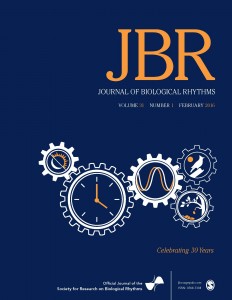Journal of Biological Rhythms
Journal of Biological Rhythms is the Society’s official journal, now for over 30 years, with a 5-year impact factor of 3.374.
For Member Access to the Journal please log in and click here.
Journal of Biological Rhythms primarily offers papers describing original research into all aspects of biological rhythms. Emphasis is placed on circadian and seasonal rhythms, but papers on other rhythms are also published. In addition to original research papers, the Journal publishes reviews, commentaries, editorials, letters, and other items of interest related to biological rhythms. Research in circadian, seasonal, and other biological rhythms is interdisciplinary. Authors have backgrounds in, and use the approaches of, ecology, neurobiology and behavior, psychology and psychiatry, endocrinology, developmental biology, pharmacology, cell biology, biochemistry, genetics, molecular biology, and mathematical modeling. The work presented is relevant to each of these disciplines, and others. Rhythms are placed within the context of the functional significance of these rhythms for the health and well-being of relevant organisms, including humans.
Every other month, the Journal presents work at the leading edge of understanding the basic nature, mechanisms, and functions underlying the generation, entrainment, and expression of biological rhythms in plants, animals, and humans.
Some of the important topics discussed include:
- Sleep-Wake Cycles
- Impact and Role of Rhythms in Health and Disease
- Rhythms and Depression
- Jet Lag and Shift Work
- Hormonal and Metabolic Rhythms
- Behavioral and Performance Rhythms
- Reproductive Cycles
- Photoperiodism, Seasonal Cycles, and Annual Cycles
- Plant Rhythms and Their Mechanisms
- Hibernation and Migration
- Cellular Clock Mechanisms
- Neuroanatomy and Neurobiology of Circadian Systems
- Melatonin and Pineal Gland
- Molecular Basis of Circadian Timing
- Identification of Genes Underlying Rhythmicity
- Control of Gene Expression by Clock Proteins
- Comparison of Rhythm Mechanisms among Life Forms
- Mechanisms of Photoreception and Photoentrainment
- Information Transfer from and among Clock Cells
- Mathematical Models of Circadian Oscillators

